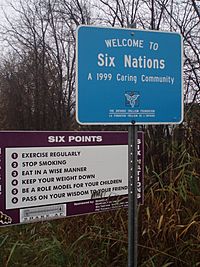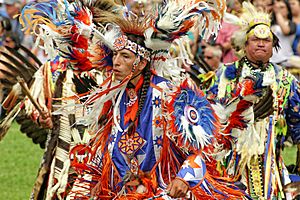Six Nations of the Grand River facts for kids
Quick facts for kids
Six Nations 40
|
||
|---|---|---|
| Six Nations Indian Reserve No. 40 | ||
 |
||
|
||
| Country | ||
| Province | ||
| County | Brant | |
| Formed | 1924 | |
| Government | ||
| • Body | Six Nations of the Grand River Elected Council | |
| Area | ||
| • Land | 183.20 km2 (70.73 sq mi) | |
| Population
(end of 2017)
|
||
| • Total | 12,848 | |
| Time zone | UTC-5 (EST) | |
| • Summer (DST) | UTC-4 (EDT) | |
| Postal Code |
N0A
|
|
| Area code(s) | 519 and 226 | |
| Website | www.sixnations.ca | |
Six Nations (also known as Six Nations of the Grand River) is the largest First Nations reserve in Canada by population. A reserve is a special area of land set aside for Indigenous peoples. As of March 2023, there were 28,520 members of the Six Nations. About 11,688 of these members live on the reserve.
The Six Nations are made up of six different Indigenous groups. These groups are the Mohawk, Cayuga, Onondaga, Oneida, Seneca, and Tuscarora. Some Lenape people, also called Delaware, also live in this area.
The Six Nations reserve is located in Ontario, Canada. It is near the city of Brantford, Ontario. The reserve covers about 186 square kilometers (71 square miles) of land. This land is bordered by the County of Brant, Norfolk County, and Haldimand County. A smaller reserve, the New Credit Reserve, is also located within its borders.
Contents
History of the Six Nations
| On-reserve population | ||
|---|---|---|
| Year | Pop. | ±% |
| 1784 | 1,843 | — |
| 1847 | 2,200 | +19.4% |
| 1858 | 2,421 | +10.0% |
| 1915 | 4,700 | +94.1% |
| 1956 | 5,850 | +24.5% |
| 1994 | 7,000 | +19.7% |
| 2013 | 12,271 | +75.3% |
| 2017 | 12,848 | +4.7% |
| Source: | ||
Many of the Haudenosaunee people, also known as the Iroquois Confederacy, sided with the British during the American Revolutionary War. Warriors from the Mohawk, Cayuga, Onondaga, and Seneca nations were especially involved. Some Oneida and Tuscarora warriors also joined them. These nations had traded with the British for a long time. They hoped the British would help stop European-American settlers from taking their lands.
After the American victory, the British gave all their land in the colonies to the new American government. This included land belonging to the Six Nations. The British did not ask the Six Nations or include them in the peace talks. The British then worked to help their Native American and European-American allies settle in Canada. They also offered some payment for the lands lost in the United States.
The British wanted these new settlers to develop farms and towns in areas west of Quebec. This territory later became known as Upper Canada. The new lands given to the Six Nations were close to important Canadian military sites. They were also placed along the border to help prevent any American invasion.
Leaders like Joseph Brant and Deseronto were important figures at this time. They faced challenges in bringing industry and farming to their lands. This was because they were prevented from giving land to business owners.
Settling on the Grand River
After the war, Mohawk leaders John Deseronto and Joseph Brant met with British commander Sir Frederick Haldimand. They talked about the lands they had lost in New York. Haldimand promised to help the Mohawk settle near the Bay of Quinte in what is now Ontario, Canada. About 200 Mohawk settled there. This area is now called the Tyendinaga Mohawk Territory, Ontario.
Joseph Brant decided he wanted to settle on the Grand River. This river is north of Lake Erie. Other Mohawk groups and bands from the other Six Nations joined him there. On October 25, 1784, the government officially granted a large area of land to the Mohawk Nation and Six Nations bands. This was done to thank them for their support during the war. The British had bought these lands from the Mississauga people earlier that year.
A count in 1785 showed 1,843 Native people living on the Grand River reserve. This included 548 Mohawk, 281 Cayuga, 145 Onondaga, 262 Oneida, 109 Tuscarora, and 98 Seneca. There were also 400 people from other tribes. These included the Lenape, Nanticoke, Tutelo, and some Creek and Cherokee people.
African-American slaves were also brought to Six Nations and Brantford by Joseph Brant. Brant encouraged his family members to marry local Black people. This helped them become part of the reserve's population. From the 1830s to the 1860s, many runaway slaves came to Six Nations through the Underground Railroad. They were also welcomed and became part of the community.
Joseph Brant also invited several white families to live on the land. Many of these were veterans who had fought with him during the war. To encourage his loyalist friends, Brant gave them larger land grants than other loyalists received elsewhere.
Early Life on the Reserve
The government provided some tools and supplies to the Haudenosaunee. These included saws, axes, and farm equipment. They also received help to set up schools and churches. Life was very hard in the first years on the frontier. The government did not provide enough help for any of the new settlers. Everyone had to build new homes and communities from the wilderness.
In 1785, the first Protestant church in Upper Canada was built on the reserve. It was called Her Majesty's Royal Chapel of the Mohawks. This chapel is still supported by the Crown today. It is one of only twelve Chapels Royal in the world.
The main town that grew was first called Brant's Town, after Joseph Brant. He built his home there. In 1798, it was a large and spread-out settlement. Brant's home was a two-story house, built in a European style. In 1797, Brant started one of the first Masonic Lodges in Upper Canada.
Governor John Simcoe confirmed the land grant on January 14, 1793. This deed said the Six Nations could only sell land to each other or to the king. Joseph Brant and the chiefs did not accept this deed. In 1795, the Grand River chiefs allowed Joseph Brant to sell large parts of land. This was land the Haudenosaunee were not using at the time. They wanted to receive payments over many years.
At this time, the population on the reserve was going down. Some Haudenosaunee left for their traditional communities in New York. After Brant started selling land in 1795, the population began to grow again. He and the chiefs wanted regular payments to help the Six Nations community.
The original land grant stretched from the mouth of the Grand River to its source. It also extended 10 kilometers (6 miles) from each side of the river. However, some of this land had not been bought from the Mississauga. Between 1795 and 1797, Joseph Brant sold about 1,544 square kilometers (381,480 acres) to land buyers. This was the northern half of the reserve.
Governor Simcoe did not agree with these land sales. The payments from these sales were supposed to bring in a lot of money each year. However, the land buyers could not sell the smaller farm lots fast enough. By 1801, all the land buyers were behind on their payments. Because of this, Brant wanted to sell more land to make up for the missing money.
In 1796, Lord Dorchester issued another deed for the land. This deed allowed the Haudenosaunee to lease or sell their land. But they had to offer it to the government first. Brant did not accept this deed. He felt it should only apply to the people currently living on the land.
By 1800, most Haudenosaunee had not yet adopted the farming style that the Canadian government wanted. Brant had hoped that selling land to European Americans would help develop the area. But conditions were difficult for this type of farming.
In 1813, the chiefs and councillors of the Six Nations in New York declared war on Canada. In 1828, chief John Brant became the superintendent for the Six Nations of the Grand River.
The Six Nations people were originally given land 10 kilometers (6 miles) on both sides of the entire Grand River. However, much of this land was later sold. The current reserve covers about 184.7 square kilometers (71 square miles). The ongoing Grand River land dispute is about these land sales.
On July 24, 2024, Ice hockey player Brandon Montour brought the Stanley Cup to Ohsweken for the first time. This happened after the Florida Panthers won their first championship. A parade was held in his honor, going from the Ohsweken Speedway to the Gaylord Powless Arena.
Communities in Six Nations
Several communities are located within the Six Nations reserve:
- Beavers Corner
- Longboat Corners
- Medina Corners
- Millers Corner
- Ohsweken
- St. Johns
- Sixty-Nine Corners
- Smith Corners
- Smoothtown
- Sour Spring
- Stoneridge
Six Nations Members
The Six Nations of the Grand River is the most populated reserve in Canada. As of March 2023, there were 28,520 band members. About 11,688 of them lived on the reserve. The population includes members from the following groups:
| Nation | Band Name | Total Members | Members on Reserve |
|---|---|---|---|
| Haudenosaunee | Bay of Quinte Mohawk | 840 | 368 |
| Lower Towns Tuscarora | 2,430 | 974 | |
| Konadaha Seneca | 621 | 207 | |
| Niharondasa Seneca | 434 | 177 | |
| Lower Mohawk | 4,456 | 2,152 | |
| Walker Mohawk | 521 | 318 | |
| Upper Mohawk | 6,802 | 2,964 | |
| Lower Cayuga | 3,881 | 1,407 | |
| Upper Cayuga | 3,996 | 1,522 | |
| Bearfoot Onondaga | 690 | 150 | |
| Clear Sky Onondaga | 876 | 452 | |
| Oneida | 2,226 | 771 | |
| Lenape | Delaware of Six Nations | 747 | 226 |
| total | 28,520 | 11,688 | |
Education in Six Nations
Before European colonization, education in Haudenosaunee communities was informal and not forced. This traditional learning continues today alongside formal schooling.
Some members of the Six Nations attended the Mohawk Institute. This was a residential school. Many reports of abuse came from this school. When it closed in 1972, the Woodland Cultural Centre took its place.
Day schools also operated on the reserve. They were managed by the Six Nations School Board from 1878 to 1933. This was the first Indigenous school board in Ontario. Even though the official curriculum was taught, Indigenous people had influence on the board. This allowed many Six Nations teachers to be hired. Many of these teachers were women, which was common for elementary schools in Ontario. Teachers on the reserve also created their own group for professional development. This group was called the Six Nations Teacher's Organization.
Notable People



